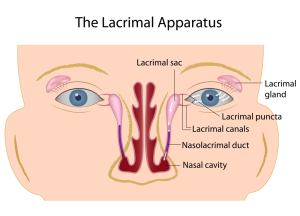Introduction
Tear system problems occur when there is a dysbalance with regard to tear fluid production in the lacrimal gland and the drainage through the tear canals. The eyes are being lubricated by the tear fluid so they can blink with a minimum of resistance/friction and it also keeps the corneas from drying out. Excess tear fluid is collected in a system of ducts that ends up in the nasolacrimal duct that drains into the inside of the nose. The tear duct can get blocked, (thanks to www.nlm.nih.gov for this link) which is common in babies. This condition is medically termed dacryostenosis.
Signs and symptoms
If the drainage channels are blocked, the tears drip over the cheek and the child gets a skin rash from the drying out of the skin. Sometimes this rash draws as much attention as the drainage problem.
When the drainage area gets blocked and infected, a condition called dacryocystitis can develop.
Diagnostic tests
Usually the diagnosis is made by careful history taking, observation and examination. In cases of infection a swab for laboratory testing may be taken to determine the infectious agent.
Treatment
The eye specialist can reopen this blocked drainage channel with a special probe.
With dacryocystitis often the specialist uses a combination of probing to overcome a blockage and subsequent treatment of the infection with antibiotics. With chronic recurrent cases the specialist may have to do a small microsurgical procedure to reestablish another drainage mechanism.
References
1. Ferri: Ferri’s Clinical Advisor: Instant Diagnosis and Treatment, 2004 ed., Copyright © 2004 Mosby, Inc.
2. Rakel: Conn’s Current Therapy 2004, 56th ed., Copyright © 2004 Elsevier







